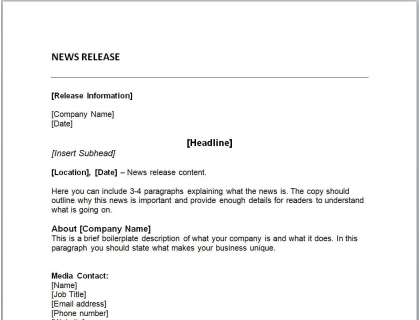How to Write an AP Style Press Release
Follow our complete guide on how to write an AP style press release. Includes informative steps, a template, and frequently asked questions.
Updated on December 15th, 2021
The SMB Guide is reader-supported. When you buy through links on our site, we may earn an affiliate commission. Learn more
An AP style press release is a media release that follows the guidelines set by the Associated Press (AP). As one of the largest news agencies in the world, the Associated Press releases an annual stylebook that is used by most journalists and media outlets.
The AP stylebook is used when businesses want to issue a press release about an event, new product or service, or announce a new hire. Typically, editors will not cover a story if the press release does not meet the industry-standard and is riddled with errors. The AP stylebook is a great way to ensure all guidelines are met, ultimately increasing your chances of having your story covered.
AP Style Press Release Template:
Download our ready customizable AP style press release template in Word format.
AP Stylebook Guidelines:
1. Punctuation.
The AP style guide does not allow the use of the Oxford or serial comma. While it may be a small detail, when listing various items, take care not to add it to your press release. In addition, only make room for one space after a period, instead of the commonly used double-space.
2. Pronoun usage.
Do not make use of first or second-person pronouns. The stylebook has strict guidelines regarding the use of pronouns. All press releases and news stories are to be written in the third person only.
3. Numbers.
Cardinal and ordinal numbers up to 10 are spelled out, while numerals are used for 10 and above. With regard to time slots, use figures instead of written words. For example, instead of "one o'clock," write it out as "1 p.m."
4. Fonts.
Avoid making use of uncommon fonts. Instead, stick to the basics like Times New Roman or Arial. This is mandatory because media outlets make use of these fonts when publishing articles. Furthermore, your font sizes should be standard sizes and only be 1 point apart in size. For example, your headline should be 14, your subhead should be 13, and your body should be 12.
5. Capitalization.
All headlines and subheads should be written in title case. This rule only applies to headlines and subheads. Other capitalizations should only be applied to the appropriate noun.
6. Dates.
Dates are the only exception when it comes to numbers. All dates should be written in numerals, while months with more than five letters should be abbreviated.
Experienced editors notice small details and too many little errors can lead to your press release being disregarded.
How to Write an AP Style Press Release:
1. Plan your press release content.
Before you start crafting your official press release, be clear on the content you want to include. A press release is often one to two pages long and makes use of concise and straightforward text. When planning your content, first write down the most basic information you want to convey.
Focus on answering the five Ws (who, what, when, where, and why). Once this is complete, you can start working around this information and adding in more details to help take your press release to the next level.
Identify your target audience. By defining your target audience’s demographics, including age, interest, gender, values, and income, you will be able to identify what content might appeal to them.
2. Provide release instructions.
A press release will typically start with the title "News Release," followed by "FOR IMMEDIATE RELEASE." This detail indicates that the information listed in the press release is ready for immediate use. However, if you're drafting an embargoed press release, be sure to write "NOT FOR IMMEDIATE RELEASE," followed by the actual publication date. The release information should always be in all caps.
3. Write your headline and subhead.
The headline should be written on top of the press release and placed in the center of the page. Because it draws the reader's attention, it is generally in bold text and between 65 and 80 characters long.
Include a descriptive subhead. The subhead is slightly longer than the headline, coming in at around 120 characters. Generally, the subhead is italicized and is placed just below the headline. Use the subhead to further explain your headline. Make sure both your headline and subhead include keywords, as journalists and readers can use these words to easily find more information through search engines.
4. Start your body.
Your body should always start with a date and location. The date should be the day of the release and the location should be the city and state the press release originated from. These sections should be in bold because it helps journalists or editors see when this story is ready for release, making it easier to determine if it works for their printing schedule. When adding the location, make sure your city is in all caps and your state is abbreviated.
Your first paragraph should answer your five Ws. Journalists often browse through various press releases every day. Therefore, it's best to get straight to the point. You can do this by answering all the five Ws. These include who is sending the release, what the release is about, when it will take place (event, new hire, the release of a new product, etc.), where it will take place, and why the news is important.
Add a feature quote. This detail adds more credibility and offers journalists direct quotes from business leaders involved in the project. Your quote should be relevant to the actual news presented in the press release. Avoid long and intricate quotes that require further explanation. A quote should only consist of two sentences.
5. Add a boilerplate.
A boilerplate is a brief description of your business. Appearing at the bottom of the press release, this "about" section includes a background of the company that quickly details its history, leadership, and the awards it has received over the years. This section should be no longer than 100 words. Be sure to end your boilerplate with a link to the company website.
6. Include contact information.
At the very bottom of the press release, include the media contact's details, as well as the business they're representing. The contact information should include the full name, phone number, and email address. It's important to note that businesses could opt to place this information at the very top of the press release as well. This option comes down to preference.
7. Determine who you want to send your release to.
Now that you've completed your press release, who will you send your press release to? The success of a well-crafted press release has a lot to do with who the press release is sent to. Because media outlets receive thousands of press releases each day, your press release will not be picked up by every publication.
It's wise to send your press release to a media outlet that serves your target audience. For example, if your press release is about a bridal expo, you will want to send your release to bridal and wedding planning publications based around your expo's location.
Who to Send your Press Release To
Find out who to send your press release to with our detailed guide. Includes helpful steps on finding the right recipient and frequently asked questions.
Apr 5, 2024
8. Distribute your press release.
For maximum exposure, we recommend using a press release distribution service. With a distribution service, your chances of getting your release to targeted media outlets and journalists that are more likely to cover the story are much higher. In addition, the distribution service covers all responsibilities, providing users with a generic template that's already in the proper format.
Press Release Distribution Services
Compare eReleases, EIN Presswire, 24-7pressrelease.com, and other top press release services. See pricing, features, ratings, and reviews.
Apr 26, 2024
FAQs:
What is Associated Press style?
The Associated Press (AP) style is a set of guidelines that governs the way media outlets, PR companies, and journalists formulate their stories or press releases.
Do you capitalize in a press release?
Yes. All headlines and subheads should be in title case, meaning most words need to start with a capital letter.
Where are datelines located in a press release?
The first sentence of the lead paragraph should start with the date and location. Your location should include the city and state the press release originated from.
What font should press releases be in?
According to the AP stylebook, the font should be in common fonts like Times New Roman or Arial.



